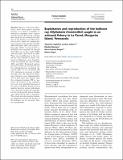| dc.contributor.author | Tagliafico, Alejandro | |
| dc.contributor.author | Eheman, Nicolás | |
| dc.contributor.author | Rangel, María Salomé | |
| dc.contributor.author | Rago, Néstor | |
| dc.date.accessioned | 2020-06-29T22:21:27Z | |
| dc.date.available | 2020-06-29T22:21:27Z | |
| dc.date.issued | 2016-01-21 | |
| dc.identifier.uri | http://hdl.handle.net/11056/17679 | |
| dc.description.abstract | Species of the genus Myli-obatis have been poorly assessed because of a lack of available information regarding their capture and life history. We provide valuable data based on the commercial landings of the bullnose ray (Myliobatis freminvillei), which we studied during 2 separate time periods (October 2005-December 2007 and January-December 2013). A total of 187 individuals were analyzed: 85 females (24.0-96.0 cm in disc width [DW]) and 102 males (22.8-118.0 cm DW). There was no difference in the overall sex ratio (females to males: 4:5); however, differences were found between the annual sex ratio in 2005, 2006, and 2013. Estimated capture per unit of effort for this species was 0.8 individuals/trip (standard deviation [SD] 1.3) or 2.9 kg/trip (SD 5.5), showing an increase in effort through time and significant differences between years. Approximately 25% of both sexes were shorter than the estimated median DW at maturity. No pattern in the reproductive cycle was identified because of the lack of landings during several months; however, mature individuals were observed frequently throughout the study period; gravid females were observed on only 2 occasions. This study provides baseline biological information on the life history of the bullnose ray for necessary fishery management. | es_ES |
| dc.description.abstract | Las especies del género Myli- obatis han sido mal evaluadas debido a la falta de información disponible sobre su captura e historia de vida. Proporcionamos datos valiosos basados en los aterrizajes comerciales del rayo de toro (Myliobatis freminvillei), que estudiamos durante 2 períodos de tiempo separados (octubre de 2005 a diciembre de 2007 y enero a diciembre de 2013). Se analizaron un total de 187 individuos: 85 mujeres (24.0–96.0 cm de ancho de disco [DW]) y 102 hombres (22.8–118.0 cm DW). No hubo diferencia en la relación sexual total (mujeres a hombres: 4: 5); sin embargo, se encontraron diferencias entre la proporción anual de sexos en 2005, 2006 y 2013. La captura estimada por unidad de esfuerzo para esta especie fue de 0.8 individuos / viaje (desviación estándar [DE] 1.3) o 2.9 kg / viaje (DE 5.5), mostrando un aumento en el esfuerzo a través del tiempo y diferencias significativas entre años. Aproximadamente el 25% de ambos sexos eran más bajos que la DW media estimada en la madurez. No se identificó ningún patrón en el ciclo reproductivo debido a la falta de aterrizajes durante varios meses; sin embargo, los individuos maduros se observaron con frecuencia durante todo el período de estudio; Se observaron hembras grávidas en solo 2 ocasiones. Este estudio proporciona información biológica de referencia sobre la historia de vida del rayo bullnose para el manejo pesquero necesario. | es_ES |
| dc.description.sponsorship | Universidad Nacional, Costa Rica | es_ES |
| dc.language.iso | eng | es_ES |
| dc.publisher | Fishery Bulletin - National Oceanic and Atmospheric Administration vol.114 no.2 144-152 2016 | es_ES |
| dc.rights | Acceso abierto | es_ES |
| dc.subject | PESCA | es_ES |
| dc.subject | PESCA ARTESANAL | es_ES |
| dc.subject | RAYAS (PECES) | es_ES |
| dc.subject | FISH INDUSTRY | es_ES |
| dc.subject | FISHERIES | es_ES |
| dc.subject | MYLIOBATIS FREMINVILLEI | es_ES |
| dc.subject | BIOLOGÍA MARINA | es_ES |
| dc.subject | VENEZUELA | es_ES |
| dc.title | Exploitation and reproduction of the bullnose ray (Myliobatis freminvillei) caught in an artisanal fishery in La Pared, Margarita Island, Venezuela | es_ES |
| dc.type | http://purl.org/coar/resource_type/c_6501 | es_ES |
| dc.description.procedence | Escuela de Ciencias Biológicas | es_ES |
| dc.identifier.doi | DOI: 10.7755/FB.114.2.2 C | |

